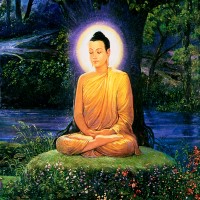
When we speak of small and medium scopes, we mean training the mind in the stages of the path shared with the small and medium scopes; we do not mean training the mind in the actual small and medium parts of the path.
Suppose there are three people: one going to Tashi Lheunpo, one to Rong, and one to Chushur. The first wants to go to Tashi Lhuenpo but must share some of the road with the other two. The three have three different things in mind – two are traveling to other Rong or Chushur, and the first intends to continue on to Tashi Lhuenpo.
So, in the small and medium-scope sections of the lamrim, you must focus on achieving Buddhahood for the sake of sentient beings. Developing Bodhicitta is the actual practice; the small- and medium-scope parts of the path are preliminaries to developing Bodhicitta. You may be wondering, “In that case it must be sufficient to teach the great scope from the outset. I doubt that the so-called small and medium are needed.”
There are two reasons for discussing all three. There are people who cannot train their minds in the great scope initially, so they need to practice in stages through the small and medium scopes. This approach is more beneficial for people with good, mediocre, or inferior minds.
Also without some familiarity with the earlier parts of the path, you will have no renunciation at all in our mindstream, so you need to defeat any pride you may have about being a Mahayanist or follower of the secret tantras.
To develop Bodhicitta, which is the actual practice, you need to develop such compassion that you simply cannot bear others being tormented by suffering. But in order to develop this compassion, you must know exactly how you yourself are plagued by suffering. And you must understand that the whole of samsara is by nature suffering.
But first you must fear the lower realms, for without this you will have no repudiation of celestial and human happiness. You must therefore train your mind in the small- medium-scope parts of the path. This training is like the foundations and wall-supports of a house.
We have not yet achieved advanced results like previous practitioners. Je Milarepa trained in the common path under Marpa, and many of his songs are about his development of these realizations. And you need the lamrim to make the especially rapid progress promised by the secret tantras. This is the implication of the names the Easy Path and the Swift Path.
That Milarepa achieve the unification in one lifetime was not due to tantra alone; he had already trained in the path of the three scopes in former lives. In one former lifetime, for example, he was Kadampa Chagtrichog, as said in the introduction to mind training.
Although people who embark on the secret tantras must have trained in the shared part of the path beforehand, we did not do this: we embarked on the secret tantras first, did not keep our tantric commitments, and thought we meditated on the two stages. They say that many such people will go to the Vajra Hell.
You must be farsighted from the beginning. You must feel,” I am prepared to use my entire human life to pursue just one meditation topic of the lamrim.” But we are farsighted about worldly things, which is the wrong way round.
Lack persistence worldly things, not the Dharma. If you feel, “It’s impossible not to achieve anything in Dharma” and practice with courage, you will not have to spend a month or a year on a single meditation topic.
Geshe Kamaba said:
“We say our contemplations achieve nothing. Why do you think that is? Don’t lie: you are distracted in the daytime and fall asleep at night!”
In other words, never mind our spending a month on a meditation topic; we have not even meditated on a single topic for the length of a single meditation session. How unrealistic to feel, “Even now I haven’t developed realizations!”
We don’t make determined practice our starting point, yet we roll our eyes into the top of our head [and pretend to meditate] when we do just one recitation of, for example, [Tsongkhapa's] Basis of All Good Qualities. If we act in this way, our wish to develop insights and realizations into the lamrim is an extremely greedy one. This is where the fault lies.
Karag Gomchung Rinpoche, a Kadampa, said:
“Look far ahead. Be farsighted. Be in tune.”
These three things are vital. The meaning is that you must look far ahead to the goal of omniscience; be farsighted about the small and medium scopes; and meditate to reach the right pitch or tension. Your practice, too, should be at the right pitch.
When you receive the Dharma orally from your guru and then practice frantically for a few days with superficial renunciation, this is a sure sign that you will make no progress.
In the small scope section, you become moved to renounce the lower realms, and in the medium scope, you are moved to renounce all samsara. But you will not achieve this unless you depend on the lamrim.
Kyabjye Pabongka Rinpoche quoted this verse by Je Rinpoche:
Anyone unattached to worldly happiness who,
Yearning to give meaning to their optimum rebirth,
Follows a path pleasing to the victors-
O fortunate ones! Listen with clear minds.
The first line refers to the correct view according to the medium scope; the second refers to the small scope section of the path; the third to bodhicitta and the great scope…
Source: Liberation in the Palm of Your Hand by Kyabjye Pabongka Rinpoche.








